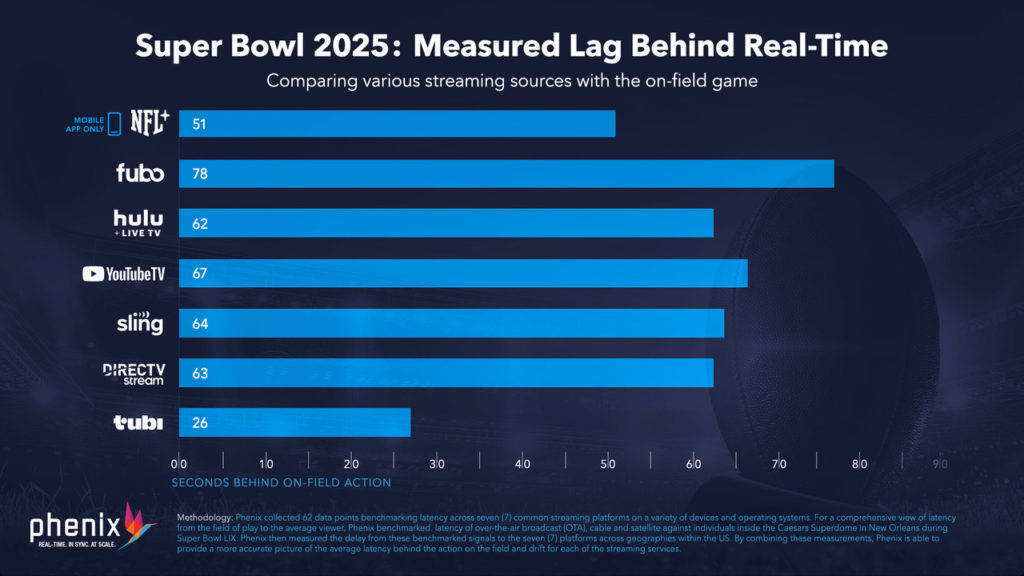Why low-latency streaming matters for sports and live events
You’re watching the biggest game of the year when your neighbour’s victory scream echoes through the wall – a full 30 seconds before you see the winning goal. Your phone buzzes with comments while you’re still watching the previous play. It’s maddening.
Data from the 2025 Super Bowl perfectly captured this frustration. Tubi achieved the best streaming performance, lagging just 26 seconds behind real-time, but most platforms were significantly worse, with many keeping viewers waiting over a minute.
If you’re a content creator, this latency problem hits even harder. Imagine trying to respond to chat messages when there’s a 30-60 second gap between what you say and when your audience sees it. Your interactive streaming becomes painfully awkward, and building genuine connections with viewers feels nearly impossible when every conversation is out of sync.
The solution? Low-latency streaming. In this article, we will walk you through how this technology works and reveal exactly where it can transform your streaming experience.

source
What is latency in video streaming?
Let’s start with the basics. Latency is simply the delay between when an event occurs and when it is watched. Think about shouting across a valley – there’s always that split second before you hear the echo bounce back. In video streaming, the same principle applies: there’s always a delay between when an event occurs in real life and when it appears on your screen.
Every time you watch a live stream, you’re seeing the past. That goal being scored at the World Cup, that last-second three-pointer in the NBA finals, that chat message being read during a live event – it all happened several seconds ago, sometimes even minutes ago. This delay exists because your video needs to travel through multiple steps before reaching your device: it gets captured, processed, sent across the internet, and finally displayed on your screen.
In most live streaming scenarios, this latency ranges from 20 seconds to two minutes. For watching a concert or a webinar, this delay doesn’t really matter. Your viewing experience remains smooth and enjoyable. But imagine watching the Super Bowl and receiving goal notifications on your phone before you see the touchdown on your TV, or trying to participate in live voting during a talent show while the results are already being announced. Suddenly, that delay becomes a real problem that breaks the entire experience.
What causes latency?
Latency occurs because it takes time for information, whether digital or not, to travel from one place to another. When you add various stops along the way, that lag can add up, creating larger delays between recording raw data and displaying it on a viewer’s device.
Think of your video as taking a complex journey with multiple checkpoints. Each stop adds a slight delay, and these quickly accumulate into the streaming latency that viewers experience.
The video streaming journey
Your live video must make several crucial stops before reaching its destination. Your camera captures raw data, which then needs to be encoded – a process that compresses and formats media files for transfer over the internet. These files typically go to a streaming server, which transcodes them (i.e., unencodes, alters according to size or resolution, and re-encodes) and transmuxes them (i.e., changes to different protocols for delivery).
From there, your video content travels through a content delivery network on its way to various devices. Each of these processing steps – capture, encoding, transmuxing, distribution, and decoding – adds its slight delay to the total latency.
Technical bottlenecks
Much like traffic jams, latency gets affected by bandwidth limitations and physical distance. When data encounters network congestion, it bottlenecks just like cars do when motorway lanes merge. Your network connection quality directly impacts how quickly video data can travel from source to destination.
Adaptive bitrate streaming helps reduce some of these issues by dynamically adjusting video quality based on each viewer’s device capabilities and internet speed. This enables faster startup times and reduced buffering, particularly when working with variable connection speeds or weaker networks.
Deliver real-time streaming without the wait!
Learn moreGeographic distance
The physical distance your data must travel creates unavoidable delays. This is why content delivery networks strategically place servers closer to viewers – reducing the distance data travels directly reduces latency. It’s the difference between shouting across a room versus shouting across a football stadium.
Network infrastructure
Every router, switch, and protocol change along the route introduces tiny delays that accumulate into noticeable wait times. As overall internet traffic grows, latency increases for all users as the digital “line” to complete transmissions backs up. These micro-latencies add up quickly, manifesting as high latency that frustrates viewers waiting for content to load.
What is low-latency video streaming?
Low-latency video streaming is a technology that minimises the delay between when an event happens in real life and when viewers see it on their screens. These solutions aim to reduce this to just a few seconds or even sub-second latency levels.
The difference might seem small on paper, but it’s transformative for interactive streaming, video chat, live gaming, and any situation where real-time engagement matters. Think about live streaming a football match where viewers can vote for the player of the game in real time, or hosting a live cooking show where the chef can immediately respond to audience questions about ingredients.
When your audience can interact with live content without that awkward delay, everything changes. Comments feel like actual conversations, live polls get immediate responses, and interactive live streaming becomes genuinely interactive rather than a delayed back-and-forth.
Where low-latency video streaming matters most
Low-latency streaming becomes critical in scenarios where real-time engagement makes or breaks the experience. Here’s where those extra seconds of delay can cost you everything:
Sports and live events
Picture watching the World Cup final where your neighbour’s cheering spoils the winning goal before you see it happen. Sports streaming demands instant action – viewers expect to see that touchdown, that knockout punch, or that game-winning shot as it happens, not 30 seconds later. Modern sports apps require low-latency video streaming to synchronise with TV broadcasts and maintain perfectly aligned second-screen experiences. When fans are following live content on social media while watching the game, even a few seconds of delay can ruin the entire experience.
Interactive entertainment and gaming
Video game streaming and esports represent the ultimate test of low latency. When a gamer streams live gameplay, viewers want to see their reactions and strategies in real-time. A delay of several seconds makes it impossible for the audience to follow along with fast-paced action or provide meaningful commentary. Professional esports tournaments require sub-second latency to maintain competitive integrity – even a few seconds of delay can reveal strategies before they’re executed.
E-commerce and live shopping
Live shopping streams on platforms like Instagram Live or TikTok Shop need low-latency video streaming to create authentic, real-time interaction. When influencers showcase products and answer audience questions instantly, viewers feel like they’re having actual conversations rather than delayed exchanges. High latency kills the spontaneous energy that drives impulse purchases and genuine engagement.
Financial services and trading
Live streaming financial news, market analysis, and trading education requires ultra-low latency to ensure viewers receive actionable information. When market conditions change rapidly, even a few seconds of delay can make the difference between profit and loss for viewers making investment decisions based on live content.
Education and training
Interactive live streaming in education – from virtual classrooms to professional training sessions – needs low latency to facilitate genuine real-time engagement. When students can ask questions and receive immediate responses, or when trainees need to react to scenarios in real-time, traditional streaming latency disrupts the learning experience.
Live music and competition shows
Eurovision, American Idol, or any live event with audience voting illustrates why low latency matters. When viewers can vote for their favourite performers in real time, traditional streaming latency creates unfair advantages – some viewers see performances 30 seconds before others, giving them more time to vote. But it’s not just about voting – imagine watching Eurovision and seeing social media explode with reactions to a performance you haven’t seen yet, or having friends comment on a singer’s outfit while you’re still watching the previous act.
Low-latency video streaming ensures everyone experiences the show simultaneously, making audience participation genuinely fair and allowing viewers to share genuine reactions on social media without spoiling the experience for others.
Examples of low-latency providers
The market for low-latency streaming has exploded, with technology providers competing to deliver the fastest, most reliable real-time streaming experiences. Here’s how major platforms use low latency to solve specific problems:
- Zoom – Video conferencing demands ultra-low latency because natural conversation becomes impossible when there’s even a few seconds of delay. Nobody wants those awkward pauses where everyone talks over each other.
- Twitch – Gaming streamers need responsive audience interaction. When viewers are commenting on gameplay, a 30-second delay means the streamer is responding to advice about enemies that are already dead.
- YouTube Live – Interactive streaming features like live polls and Q&A sessions become meaningless when there’s a significant delay between questions and responses.
Ready to eliminate streaming latency?
The numbers are clear: 47% of consumers unsubscribe from streaming services due to buffering issues, and viewers consider cancelling after just 13.5 seconds of poor performance. When delays of 30-78 seconds (like those measured during the 2025 Super Bowl) become the norm, low-latency streaming isn’t optional – it’s essential for keeping your audience engaged.
At Spyrosoft, we help media companies implement streaming solutions that deliver the performance modern audiences demand. Our expertise ensures your streams reach viewers with minimal delay and maximum engagement.
Discover how we can optimise your streaming strategy with proven low-latency solutions.
About the author
Contact us





![[thumbnail] media and entertainment - android tv guide](https://spyro-soft.com/wp-content/uploads/2025/06/thumbnail-media-and-entertainment-android-tv-guide-1024x655.png)